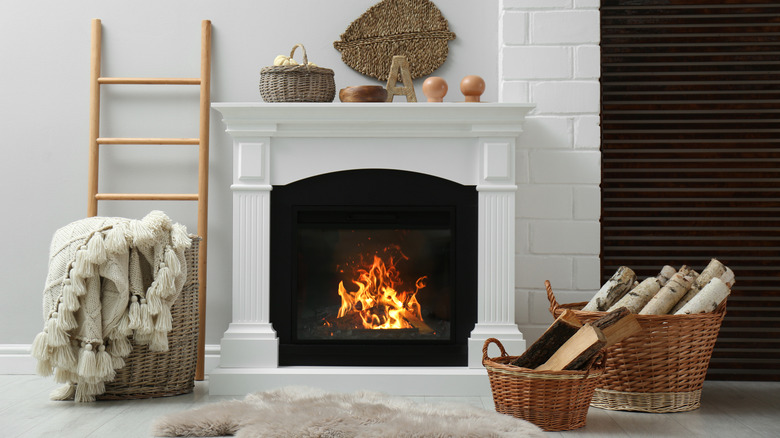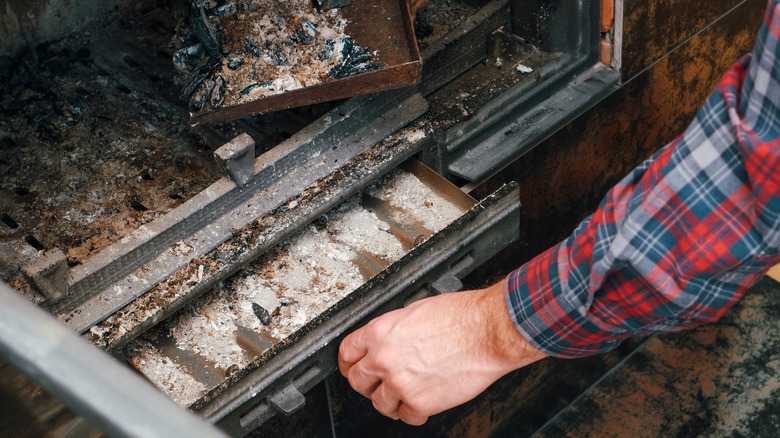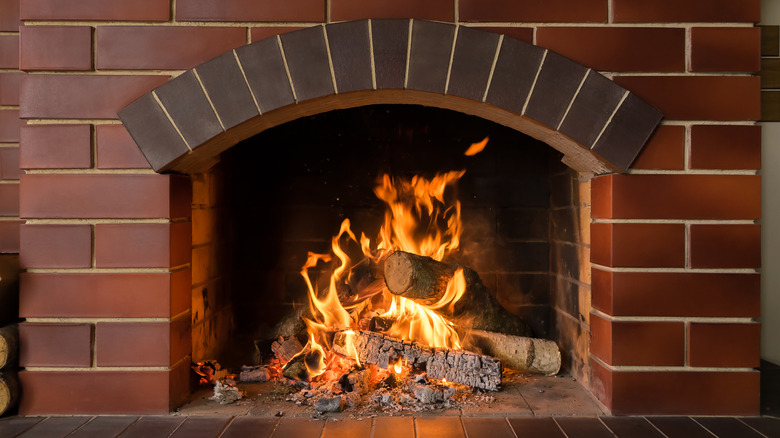How To Successfully Clean Fireplace Bricks
A wood-burning fireplace is the heart of a welcoming house. And although it can be a great focal point in a living room, it can also be tough to keep clean. Using your brick fireplace, no matter how well you maintain it, will inevitably result in a soot buildup on the hearth and façade. As Service Master Restore explains, soot is a tiny particle that forms when organic and carbon-filled materials are not entirely burnt. Soot builds on bricks, ceramic tiles and grout, draperies and upholstery, carpets, and painted surfaces, leaving a smoky odor and ugly black marks. It's critical to clean soot regularly since it can cause long-term harm, especially to porous surfaces.
When you notice those streaks and stains on your fireplace bricks, it's time for deep cleaning. And because bricks are porous (or have microscopic holes in their surface), the more frequently you use a fireplace, the more regularly you'll need to clean it. The quicker you remove soot discoloration from fireplace bricks, the less difficult the job will be. On that note, there's a solution to clean fireplace bricks that makes this work considerably easier.
Brush away soot and ashes, then vacuum
Because this will be dirty and spills and stains will inevitably occur, it's a good idea to lay down an old sheet or a waterproof drop cloth. Also, use water with caution to avoid damaging the floor. If you don't have any waterproof cloths on hand, use plastic mats.
To avoid having a mess on your hands, when adding the cleaning solution to the bricks' surface, wipe off any loose ash and soot first. A broom and a vacuum cleaner with a brush attachment are ideal for this task. Brush the brickwork well with a broom and move to the soot with a brush attached to the vacuum. Finally, remove as much soot and dust as possible by vacuuming the fireplace surroundings and hearth. Fireplace Fact recommends using a shop vacuum to collect any minute particles after properly and safely disposing of the ashes.
If old paint stains appear as you clean the fireplace, apply paint stripper to the spots with a trowel and leave for several hours, scraping away as much as possible. You may also wish to scrub the bricks with plain water to remove any remaining paint as well as the chemicals.
Scrub your fireplace bricks
Are you ready for squeaky-clean fireplace bricks? Then let's get started. Before you begin, make sure that the fireplace bricks are entirely cool; not only are hot bricks unsafe to touch, but they also don't respond well to cleaning attempts.
First things first: Wet the bricks. Using a damp sponge, soak the brick fireplace with regular water before mixing your cleaning solution. The porous sides of the bricks absorb water, making it easier for dishwashing detergent to stick to the wall afterward rather than running down it. As the water soaks in, The Brick Industry Association recommends that you prepare your cleaning solution. It would help to choose a grease-fighting dish detergent, which you dilute 1/4 cup to 4 cups of water. You'll need around 1 gallon of water for this, as it may take several cycles.
Cover the brickwork with the cleaning materials in your spray bottle. Then, deep clean in a circular motion with a scrubbing brush to remove as much soot as possible. Clean your scrub brush in a separate bucket of clean water between uses — it'll undoubtedly need it! Using clean water and a microfiber towel, remove all the soapy suds. Examine the results and, if necessary, repeat the process. When you're done, wait until the bricks are completely dry before lighting a fire; otherwise, you'll undo all of your hard work. It's well worth the wait — just don't clean it on a cold night!


